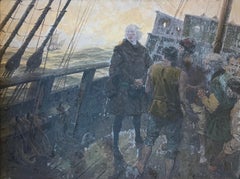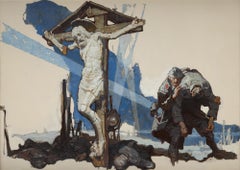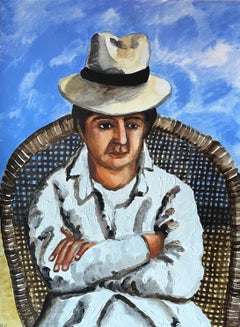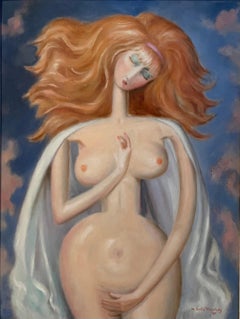Want more images or videos?
Request additional images or videos from the seller
1 of 9
David Sherwin ParkerDays Like This1958-2023
1958-2023
Price:$1,500
$1,700List Price
About the Item
- Creator:David Sherwin Parker (1958, American)
- Creation Year:1958-2023
- Dimensions:Height: 8 in (20.32 cm)Width: 10 in (25.4 cm)
- Medium:
- Movement & Style:
- Period:
- Condition:
- Gallery Location:Cliffside Park, NJ
- Reference Number:1stDibs: LU2358213857402
About the Seller
5.0
Vetted Professional Seller
Every seller passes strict standards for authenticity and reliability
1stDibs seller since 2023
17 sales on 1stDibs
Typical response time: 22 hours
Authenticity Guarantee
In the unlikely event there’s an issue with an item’s authenticity, contact us within 1 year for a full refund. DetailsMoney-Back Guarantee
If your item is not as described, is damaged in transit, or does not arrive, contact us within 7 days for a full refund. Details24-Hour Cancellation
You have a 24-hour grace period in which to reconsider your purchase, with no questions asked.Vetted Professional Sellers
Our world-class sellers must adhere to strict standards for service and quality, maintaining the integrity of our listings.Price-Match Guarantee
If you find that a seller listed the same item for a lower price elsewhere, we’ll match it.Trusted Global Delivery
Our best-in-class carrier network provides specialized shipping options worldwide, including custom delivery.You May Also Like
FIRE
By Martin Mull
Located in New York, NY
Martin Mull is a singular artist whose iconography directly translate the American culture.
Category
21st Century and Contemporary American Modern Figurative Paintings
Materials
Oil, Canvas
The Lure of Real Estate
By Martin Mull
Located in New York, NY
Martin Mull is a singular artist whose iconography directly translate the American culture.
Category
21st Century and Contemporary American Modern Figurative Paintings
Materials
Canvas, Oil
Ladies In Waiting
By Martin Mull
Located in New York, NY
Martin Mull is a singular artist whose iconography directly translate the American culture.
Category
21st Century and Contemporary American Modern Figurative Paintings
Materials
Canvas, Oil
Lost Sheep
By Martin Mull
Located in New York, NY
Martin Mull is a singular artist whose iconography directly translate the American culture.
Category
21st Century and Contemporary American Modern Figurative Paintings
Materials
Canvas, Oil
Judy and Rita on Porch at Afton
Located in Los Angeles, CA
Judy and Rita on Porch at Afton, c. 1936, oil on canvas, 24 x 36 inches, title inscribed on tacking margin; “Judy” and “Rita” inscribed verso, NB: purchased together with The New Roa...
Category
1930s American Modern Figurative Paintings
Materials
Canvas, Oil
Conjuring Spirits (Jungle Drums)
By Thomas Hart Benton
Located in Wilton Manors, FL
Dynamic jungle drummer scene by unknown NYC American artist. Oil on canvas measuring 20 x 26 inches. Signed "T 42" in ink on verso. Anco stretchers and Grumbacher NYC store stamp con...
Category
Mid-20th Century American Modern Abstract Paintings
Materials
Oil
A Colorful, Dynamic 1930s Modern Boxing Scene by Chicago Artist, Francis Chapin
By Francis Chapin
Located in Chicago, IL
A Colorful, Dynamic 1930s Modern Boxing Scene by Notable Chicago Artist, Francis Chapin. Artwork size: 2 3/4 x 4 inches, oil on Masonite on original mount, framed in striking perio...
Category
Mid-20th Century American Modern Abstract Paintings
Materials
Masonite, Oil
$950
H 11 in W 12.75 in D 1.25 in
A Colorful, 1950s Mid-Century Modern Pool Hall Scene by Francis Chapin
By Francis Chapin
Located in Chicago, IL
A Vibrant, Colorful, 1950s Mid-Century Modern Pool Hall Scene by Notable Chicago Artist, Francis Chapin. Artwork size: 6 3/4" x 8 1/2", Oil on Masonite, Framed size: 11" x 12 1/2"....
Category
Mid-20th Century American Modern Abstract Paintings
Materials
Masonite, Oil
$950
H 11 in W 12.5 in D 1 in
The Speed God Mercury, Collier's Magazine Cover
By Joseph Christian Leyendecker
Located in Fort Washington, PA
Medium: Oil on Canvas
Signature: Signed Lower Left
Sight Size 29.25" x 21.00", Framed 44.00" x 35.00"
The Speed God Mercury, Collier's Magazine Cover, January 19, 1907
Leyendecker,...
Category
Early 1900s American Modern Figurative Paintings
Materials
Oil
Price Upon Request
H 29.25 in W 21 in
Alka Seltzer Advertisement
Located in Fort Washington, PA
Medium: Oil on Canvas
Size: 40" x 20"
Category
20th Century American Modern Figurative Paintings
Materials
Canvas, Oil
More From This Seller
View AllColumbus Refuses a Plea to Turn Back
By Tom Lovell
Located in Cliffside Park, NJ
Tom Lovell (1909–1997) called himself "a storyteller with a brush," a description appropriate for an artist who spent over five decades capturing the sweep o...
Category
Mid-20th Century Realist Figurative Paintings
Materials
Oil Pastel, Oil, Board, Illustration Board
Untitled (Crucifixion on the Battlefield)
By Dean Cornwell
Located in Cliffside Park, NJ
One of the most successful illustrators of the early 20th century Dean Cornwell
Untitled (Crucifixion on the Battlefield)
initialed DC (center left), oil on canvas, framed
canvas: 33...
Category
Early 20th Century Post-Impressionist Figurative Paintings
Materials
Oil, Canvas
Man in a wicker chair
Located in Cliffside Park, NJ
Natalya Nesterova has created her own enormous world and has found her own angle of vision in the reality that surrounds us. As an artist, she sees this world in a way that we cannot. The air of mystery permeates Nesterova's works; the surrealistic impulse is definitely present in her paintings. But neither it or any other terminologically defined influence predominates over the freedom and talent of the personality in choosing an independent style and organization of creative ideas. Natalya Nesterova is recognized as one of the most important and internationally acclaimed contemporary Russian artists.
Category
2010s Surrealist Figurative Paintings
Materials
Canvas, Oil
Untitled (Venus)
Located in Cliffside Park, NJ
Manuel Soto-Muñoz (1913-2000), Puerto Rican born American painter. Recipient award of merit Florida Southern College, 1958; prize Art Students League New York, 1950; 1st prize Salón ...
Category
Late 20th Century Contemporary Figurative Paintings
Materials
Oil
Untitled (Nymphs at Swan Pond)
Located in Cliffside Park, NJ
A pretty baroque-style painting.
Category
20th Century Baroque Figurative Paintings
Materials
Oil, Acrylic
Untitled (Women)
Located in Cliffside Park, NJ
Large and impressive painting by Louis Harris, 1902-1970
Born in St. Louis, Harris moved to New York in 1920 and studied at the Art Students League with Max Weber. There he met other...
Category
1930s Abstract Expressionist Figurative Paintings
Materials
Oil
Recently Viewed
View AllMore Ways To Browse
Military Oil Painting
Nude Mother
Oil Paintings Feather
Russian Civil War
Stage Design Art
16th Century Painted Panels
Adolf Zardins
At The Moulin Rouge
Blonde Girl
Blue Venus
Circus Tent Used
Cowboy Pop Art
Framed Vintage Advertisements
French Art 1800
Oil Painting Piano
Painting Woman Reading
Paintings Of Insects
Peasant Oil Paintings



